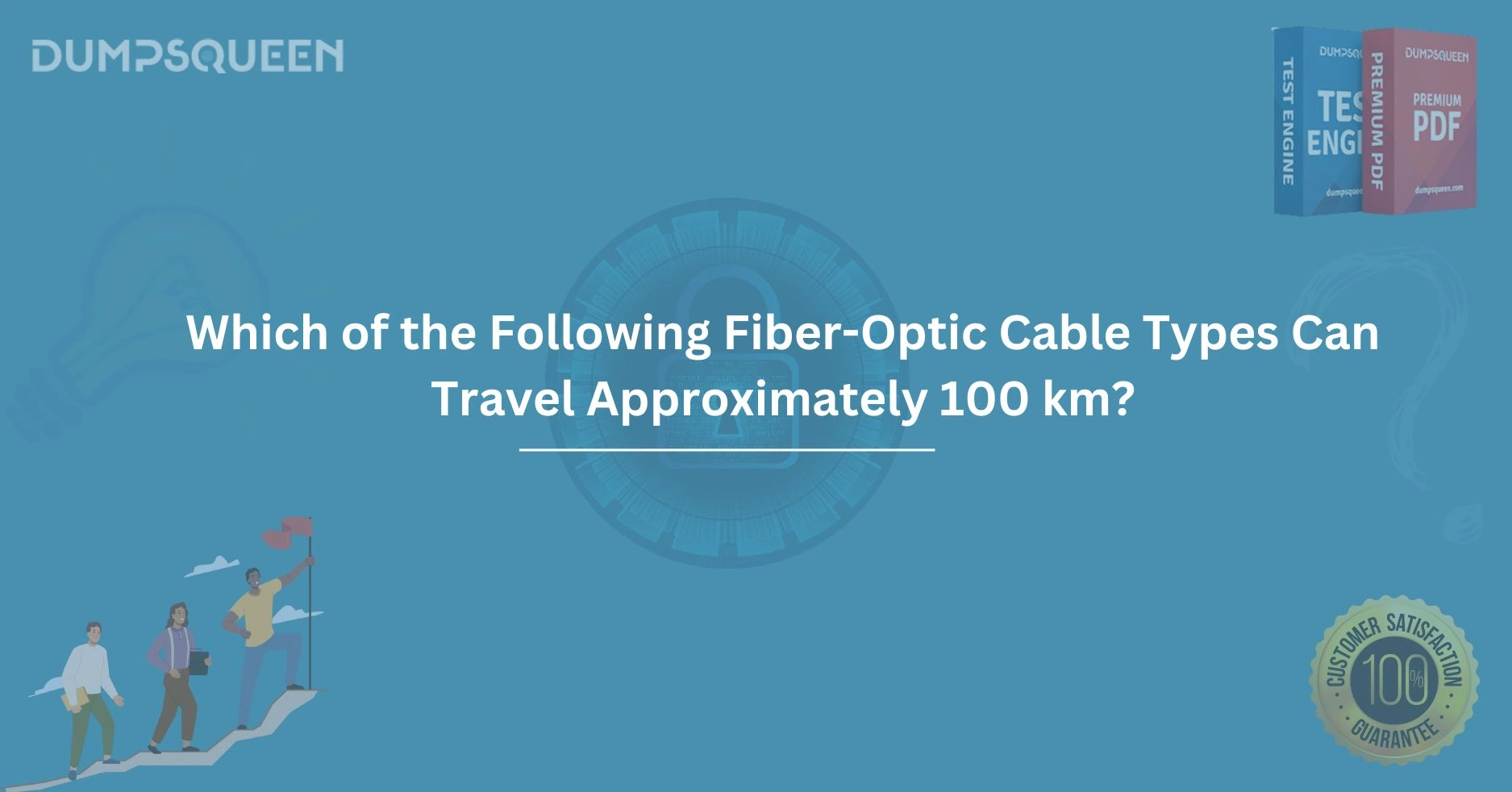Introduction
In today’s interconnected world, fiber-optic cables serve as the backbone of high-speed communication networks, enabling the seamless transfer of data across vast distances. These cables, made of thin strands of glass or plastic, transmit data as pulses of light, offering unparalleled speed and reliability compared to traditional copper cables. For professionals in telecommunications, networking, or IT certification candidates preparing for exams, understanding the capabilities of different fiber-optic cable types is essential. One common question that arises is: Which of the following fiber-optic cable types can travel approximately 100 km? This question not only tests technical knowledge but also highlights the importance of selecting the right cable for long-distance communication. In this comprehensive guide, brought to you by DumpsQueen, we will explore the various types of fiber-optic cables, their characteristics, and their maximum transmission distances to provide a clear answer. By delving into the technical details and practical applications, this article aims to equip readers with the knowledge needed to excel in their professional endeavors or certification exams.
The Fundamentals of Fiber-Optic Cables
Fiber-optic cables operate by transmitting light signals through a core surrounded by a cladding layer, which reflects the light back into the core to minimize signal loss. The cables are categorized into two primary types: single-mode and multimode. Each type has distinct properties that determine its suitability for specific applications, including the distance over which it can effectively transmit data. Understanding these differences is critical for answering questions about transmission distances, such as those encountered in certification exams supported by resources from DumpsQueen.
Single-mode fiber (SMF) features a small core diameter, typically around 8 to 10 micrometers, allowing only one mode of light to propagate. This design reduces signal dispersion, enabling data to travel longer distances without significant loss. Multimode fiber (MMF), on the other hand, has a larger core diameter, usually 50 or 62.5 micrometers, which supports multiple light modes. While this allows for higher bandwidth over short distances, it leads to greater signal dispersion, limiting its range compared to single-mode fiber.
Beyond the core type, fiber-optic cables are further classified based on their construction, wavelength compatibility, and performance specifications, such as OM (Optical Multimode) and OS (Optical Single-mode) categories. These classifications help professionals determine which cable is best suited for a given distance or application, a topic frequently explored in technical certifications.
Single-Mode Fiber: The Long-Distance Champion
When considering the question of which fiber-optic cable type can travel approximately 100 km, single-mode fiber emerges as the clear frontrunner. Designed for long-haul communication, single-mode fiber is widely used in applications such as metropolitan area networks (MANs), wide area networks (WANs), and submarine communication systems. Its ability to transmit data over extended distances without requiring signal regeneration makes it ideal for scenarios where connectivity spans tens or even hundreds of kilometers.
The key to single-mode fiber’s long-distance capability lies in its narrow core, which minimizes modal dispersion. Modal dispersion occurs when different light modes arrive at the destination at slightly different times, causing signal distortion. In single-mode fiber, only one light path exists, ensuring that the signal remains intact over long distances. Additionally, single-mode fiber typically operates at a wavelength of 1310 nm or 1550 nm, both of which experience lower attenuation (signal loss) compared to the shorter wavelengths used in multimode fiber.
In practical terms, single-mode fiber can transmit data up to 100 km or more, depending on the quality of the cable, the transmitter, and the receiver. For example, high-quality single-mode cables paired with advanced optical amplifiers, such as erbium-doped fiber amplifiers (EDFAs), can extend transmission distances well beyond 100 km. This capability makes single-mode fiber the preferred choice for long-distance telecommunications networks, a fact that certification candidates using DumpsQueen resources should note when preparing for related exam questions.
Multimode Fiber: Designed for Shorter Distances
While single-mode fiber excels in long-distance applications, multimode fiber is optimized for shorter distances, typically within buildings or campuses. Due to its larger core size, multimode fiber supports multiple light paths, which increases bandwidth but also introduces modal dispersion. This dispersion limits the distance over which multimode fiber can transmit data without significant signal degradation.
Multimode fiber is categorized into several types, including OM1, OM2, OM3, OM4, and OM5, each with different performance characteristics. For instance, OM1 and OM2 fibers, with core sizes of 62.5 µm and 50 µm respectively, are older standards designed for legacy systems. These fibers typically support distances of up to 275 meters at 1 Gbps or 550 meters at 100 Mbps, far short of the 100 km mark. Newer standards, such as OM3 and OM4, are optimized for higher speeds, supporting 10 Gbps or 40 Gbps over distances of 300 to 400 meters. OM5, the latest multimode standard, extends this range slightly but still falls within the kilometer range, not tens of kilometers.
Given these limitations, multimode fiber is not a viable candidate for transmitting data approximately 100 km. Professionals studying with DumpsQueen materials will find that understanding these distance constraints is crucial for answering exam questions accurately and selecting the appropriate cable type in real-world scenarios.
Comparing Cable Types for Long-Distance Transmission
To directly address the question of which fiber-optic cable type can travel approximately 100 km, a comparison of single-mode and multimode fibers is necessary. Single-mode fiber’s ability to maintain signal integrity over long distances makes it the only type capable of meeting this requirement in most practical applications. Multimode fiber, while cost-effective and suitable for high-bandwidth, short-distance applications, cannot compete with single-mode fiber’s range.
In addition to core size and dispersion characteristics, other factors influence a cable’s maximum transmission distance. These include the quality of the optical transceivers, the wavelength used, and the presence of amplifiers or repeaters. For single-mode fiber, advancements in optical technology have pushed transmission distances beyond 100 km, with some systems achieving ranges of 200 km or more without regeneration. However, for the purposes of certification exams and standard networking scenarios, single-mode fiber is reliably associated with distances up to 100 km, aligning with the question posed.
Resources from DumpsQueen emphasize the importance of recognizing these distinctions, as exam questions often test candidates’ ability to match cable types to specific use cases. By focusing on single-mode fiber for long-distance applications, candidates can confidently select the correct answer when faced with questions about 100 km transmission ranges.
Practical Applications of Single-Mode Fiber
Single-mode fiber’s ability to transmit data over approximately 100 km has made it indispensable in various industries. Telecommunications providers rely on single-mode fiber to connect cities and regions, forming the backbone of global internet infrastructure. Similarly, cable television and internet service providers use single-mode fiber for long-haul connections between central offices and distribution hubs.
In enterprise settings, single-mode fiber is deployed in scenarios requiring connectivity between geographically separated data centers or campuses. For example, a university with multiple campuses spread across a large metropolitan area might use single-mode fiber to ensure high-speed, reliable communication between locations. Additionally, single-mode fiber is critical in specialized applications, such as undersea cables, where data must travel thousands of kilometers without interruption.
For professionals preparing for certifications through DumpsQueen, understanding these real-world applications reinforces the theoretical knowledge needed to answer questions about fiber-optic cable types. By connecting technical specifications to practical use cases, candidates can better grasp why single-mode fiber is the go-to choice for long-distance transmission.
Challenges and Considerations in Long-Distance Fiber-Optic Transmission
While single-mode fiber is well-suited for 100 km transmissions, several challenges must be addressed to ensure optimal performance. Attenuation, though lower in single-mode fiber than in multimode, still occurs over long distances, particularly at higher wavelengths. To mitigate this, network engineers use optical amplifiers or repeaters to boost the signal at regular intervals.
Another consideration is chromatic dispersion, where different wavelengths of light travel at slightly different speeds, causing signal distortion. Single-mode fiber minimizes this effect, but advanced systems may employ dispersion-compensating modules for ultra-long distances. Additionally, the cost of single-mode fiber and its associated equipment is generally higher than that of multimode fiber, which may influence decisions in budget-constrained projects.
Certification candidates using DumpsQueen resources should be aware of these challenges, as exam questions may test not only the maximum distance of a cable type but also the factors affecting its performance. By understanding both the strengths and limitations of single-mode fiber, professionals can make informed decisions in both exam and real-world contexts.
Conclusion
In the realm of fiber-optic communication, selecting the right cable type for a given distance is a critical decision that impacts performance, cost, and reliability. When faced with the question, Which of the following fiber-optic cable types can travel approximately 100 km?, the answer is unequivocally single-mode fiber. Its narrow core, low dispersion, and compatibility with long-haul wavelengths make it the ideal choice for transmitting data over vast distances, from metropolitan networks to global communication systems. While multimode fiber serves a vital role in short-distance, high-bandwidth applications, it cannot match single-mode fiber’s range.
For professionals and certification candidates, understanding the nuances of fiber-optic cables is not just about passing exams—it’s about building the expertise needed to design and maintain robust networks. Resources from DumpsQueen provide the guidance and practice necessary to master these concepts, ensuring success in both academic and professional pursuits. By exploring the technical details, practical applications, and challenges of fiber-optic transmission, this guide has aimed to illuminate why single-mode fiber stands out as the solution for 100 km connectivity, empowering readers to confidently tackle related questions and real-world challenges.
Free Sample Questions
- Which of the following fiber-optic cable types can transmit data approximately 100 km?
A) OM3 Multimode Fiber
B) Single-Mode Fiber
C) OM1 Multimode Fiber
D) OM4 Multimode Fiber
Answer: B) Single-Mode Fiber - What is the primary reason single-mode fiber can transmit data over longer distances than multimode fiber?
A) Larger core diameter
B) Lower modal dispersion
C) Higher bandwidth capacity
D) Use of multiple wavelengths
Answer: B) Lower modal dispersion - Which multimode fiber type supports the longest transmission distance at 10 Gbps?
A) OM1
B) OM2
C) OM3
D) OM4
Answer: D) OM4



